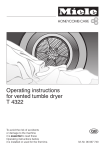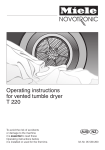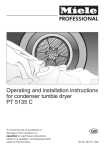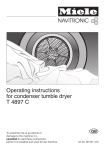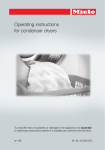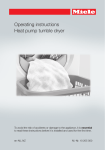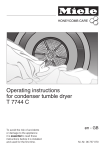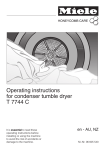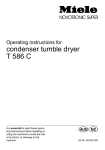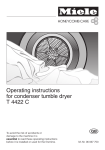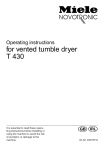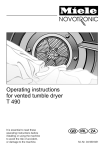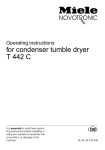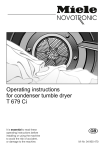Download Miele T 220 Operating instructions
Transcript
Operating instructions for vented tumble dryer T 220 To avoid the risk of accidents or damage to the machine it is essential to read these instructions before it is installed or used for the first time. G M.-Nr. 05 538 670 Contents Warning and Safety instructions . . . . . . . . . . . . . . . . . . . . . . . . . . . . . . . . . . . . . 4 Caring for the environment . . . . . . . . . . . . . . . . . . . . . . . . . . . . . . . . . . . . . . . . . . 8 Disposal of the packing material . . . . . . . . . . . . . . . . . . . . . . . . . . . . . . . . . . . . . . . 8 Disposal of your old appliances . . . . . . . . . . . . . . . . . . . . . . . . . . . . . . . . . . . . . . . 8 Energy saving tips . . . . . . . . . . . . . . . . . . . . . . . . . . . . . . . . . . . . . . . . . . . . . . . . . . 8 Control panel . . . . . . . . . . . . . . . . . . . . . . . . . . . . . . . . . . . . . . . . . . . . . . . . . . . . . 9 Notes on laundry care . . . . . . . . . . . . . . . . . . . . . . . . . . . . . . . . . . . . . . . . . . . . 10 Programme chart . . . . . . . . . . . . . . . . . . . . . . . . . . . . . . . . . . . . . . . . . . . . . . . . . 11 How to dry correctly . . . . . . . . . . . . . . . . . . . . . . . . . . . . . . . . . . . . . . . . . . . . . . 14 A Prepare the laundry. . . . . . . . . . . . . . . . . . . . . . . . . . . . . . . . . . . . . . . . . . . . . . 14 B Load the drum and switch on the dryer . . . . . . . . . . . . . . . . . . . . . . . . . . . . . . 14 C Select a programme . . . . . . . . . . . . . . . . . . . . . . . . . . . . . . . . . . . . . . . . . . . . . 15 D Start the programme . . . . . . . . . . . . . . . . . . . . . . . . . . . . . . . . . . . . . . . . . . . . . 15 Selecting a different programme . . . . . . . . . . . . . . . . . . . . . . . . . . . . . . . . . . . 16 Interrupting a programme. . . . . . . . . . . . . . . . . . . . . . . . . . . . . . . . . . . . . . . . . 16 Adding or removing items . . . . . . . . . . . . . . . . . . . . . . . . . . . . . . . . . . . . . . . . 16 To cancel a programme . . . . . . . . . . . . . . . . . . . . . . . . . . . . . . . . . . . . . . . . . . 16 E At the end of a programme . . . . . . . . . . . . . . . . . . . . . . . . . . . . . . . . . . . . . . . . 16 Cleaning and care . . . . . . . . . . . . . . . . . . . . . . . . . . . . . . . . . . . . . . . . . . . . . . . . 17 Cleaning the fluff filter . . . . . . . . . . . . . . . . . . . . . . . . . . . . . . . . . . . . . . . . . . . . . . 17 Tumble dryer . . . . . . . . . . . . . . . . . . . . . . . . . . . . . . . . . . . . . . . . . . . . . . . . . . . . . 18 Problem solving guide. . . . . . . . . . . . . . . . . . . . . . . . . . . . . . . . . . . . . . . . . . . . . 19 General problems . . . . . . . . . . . . . . . . . . . . . . . . . . . . . . . . . . . . . . . . . . . . . . . . . 19 Check and fault indicator lamps . . . . . . . . . . . . . . . . . . . . . . . . . . . . . . . . . . . . . . 22 To change the interior drum lamp. . . . . . . . . . . . . . . . . . . . . . . . . . . . . . . . . . . 23 After sales service . . . . . . . . . . . . . . . . . . . . . . . . . . . . . . . . . . . . . . . . . . . . . . . . . 24 Repairs . . . . . . . . . . . . . . . . . . . . . . . . . . . . . . . . . . . . . . . . . . . . . . . . . . . . . . . 24 PC indicator lamp (interface for service technicians). . . . . . . . . . . . . . . . . . . . 24 Optional accessories . . . . . . . . . . . . . . . . . . . . . . . . . . . . . . . . . . . . . . . . . . . . 24 2 Contents Installation and connection . . . . . . . . . . . . . . . . . . . . . . . . . . . . . . . . . . . . . . . . 25 Front view. . . . . . . . . . . . . . . . . . . . . . . . . . . . . . . . . . . . . . . . . . . . . . . . . . . . . . . . 25 Installation site . . . . . . . . . . . . . . . . . . . . . . . . . . . . . . . . . . . . . . . . . . . . . . . . . . . . 26 Transporting the machine to its installation site . . . . . . . . . . . . . . . . . . . . . . . . 26 Building under a continous worktop / in a kitchen run . . . . . . . . . . . . . . . . . . . 26 Levelling the machine. . . . . . . . . . . . . . . . . . . . . . . . . . . . . . . . . . . . . . . . . . . . 27 Washer-dryer stack. . . . . . . . . . . . . . . . . . . . . . . . . . . . . . . . . . . . . . . . . . . . . . 27 Electrical connection . . . . . . . . . . . . . . . . . . . . . . . . . . . . . . . . . . . . . . . . . . . . . 28 Electrical connection U.K. . . . . . . . . . . . . . . . . . . . . . . . . . . . . . . . . . . . . . . . . . . . 28 Installation - venting . . . . . . . . . . . . . . . . . . . . . . . . . . . . . . . . . . . . . . . . . . . . . . 29 General . . . . . . . . . . . . . . . . . . . . . . . . . . . . . . . . . . . . . . . . . . . . . . . . . . . . . . . . . 29 Calculating the effective duct length: . . . . . . . . . . . . . . . . . . . . . . . . . . . . . . . . . . 30 Installation to the left or right side of the machine . . . . . . . . . . . . . . . . . . . . . . . . . 31 Adapter . . . . . . . . . . . . . . . . . . . . . . . . . . . . . . . . . . . . . . . . . . . . . . . . . . . . . . . . . 32 a Venting system with flexible ducting hose . . . . . . . . . . . . . . . . . . . . . . . . . . . . 32 b Venting system with plastic piping . . . . . . . . . . . . . . . . . . . . . . . . . . . . . . . . . . 34 c Connecting directly to a wall vent . . . . . . . . . . . . . . . . . . . . . . . . . . . . . . . . . . . 35 Washer dryer stack . . . . . . . . . . . . . . . . . . . . . . . . . . . . . . . . . . . . . . . . . . . . . . . . 36 Consumption data . . . . . . . . . . . . . . . . . . . . . . . . . . . . . . . . . . . . . . . . . . . . . . . . 37 Technical data . . . . . . . . . . . . . . . . . . . . . . . . . . . . . . . . . . . . . . . . . . . . . . . . . . . 38 Programmable functions. . . . . . . . . . . . . . . . . . . . . . . . . . . . . . . . . . . . . . . . . . . 41 Increased drying level in the COTTONS programmes . . . . . . . . . . . . . . . . . . . . . 41 Increased drying level in the MINIMUM IRON programmes . . . . . . . . . . . . . . . . . 42 Buzzer . . . . . . . . . . . . . . . . . . . . . . . . . . . . . . . . . . . . . . . . . . . . . . . . . . . . . . . . . . 43 3 Warning and Safety instructions Technical safety To avoid the risk of accidents and damage to the machine please read these instructions carefully before using it for the first time. They contain important information on its safety, installation, use and maintenance. Keep these instructions in a safe place and ensure that new users are familiar with the content. Pass them on to any future owner of the machine. Correct use The tumble dryer is only intended for drying fabrics which have been washed in a water solution, marked on the manufacturer's care label as being suitable for tumble drying. "Dry cleaning kits" for freshening up garments in a tumble dryer are increasingly available on the market. If using, do so at your own risk, and follow the instructions provided on the packaging. Any other applications may be dangerous. The manufacturer is not liable for damage resulting from improper use or operation. 4 Before setting up the machine, check it for any externally visible damage. Do not install or use a damaged machine. Before connecting the machine, ensure that the connection data on the data plate (voltage and connected load) match the mains electricity supply. If in any doubt, consult a qualified electrician. The electrical safety of this machine can only be guaranteed when continuity is complete between it and an effective earthing system which complies with local and national regulations. It is most important that this basic safety requirement is present and regularly tested, and where there is any doubt the household wiring system should be inspected by a qualified electrician. The manufacturer cannot be held liable for the consequences of an inadequate earthing system (e.g. electric shock). Do not connect the appliance to the mains electricity supply by an extension lead. Extension leads do not guarantee the required safety of the appliance (e.g. danger of overheating). Warning and Safety instructions The machine is built in accordance with current safety requirements. Unauthorised repairs could result in unforeseen dangers for the user, for which the manufacturer cannot accept liability. Repairs should only be undertaken by a Miele approved technician. Ensure current is not supplied to the machine until after maintenance or repair work has been carried out. Faulty components must only be replaced by genuine Miele original spare parts. Only when these parts are fitted can the safety standards of the machine be guaranteed. If the connection cable is faulty it must only be replaced by a Miele approved service technician to protect the user from danger. In countries where there are areas which may be subject to infestation by cockroaches or other vermin, pay particular attention to keeping the machine and its surroundings in a clean condition at all times. Any damage which may be caused by cockroaches or other vermin will not be covered by the machine guarantee. 5 Warning and Safety instructions In the event of a fault or for cleaning purposes, the machine is only completely isolated from the electricity supply when: – it is switched off at the wall socket and the plug is withdrawn, or – it is switched off at the mains, or – the mains fuse is withdrawn. Use This equipment may only be used in mobile installations such as ships, caravans, aircraft etc. if a risk assessment of the installation has been carried out by a suitably qualified engineer. This dryer must not be: – connected to a chimney or vent flue which is in use. – used without exhaust ducting. – used without the fluff filter in place of if the fluff filter is damaged in any way. Check all parts of the extraction system on a regular basis (e.g. wall vent, external grille, bends in the ducting etc.) and make sure they are all free of any hindrance. A build-up of fluff will prevent a free-flow of air through the system. If the dryer is to be connected to an existing ducting system this must be checked for suitability beforehand. 6 Adequate ventilation is essential to avoid the danger of asphyxia and toxic fumes where another appliance which also uses the room air (e.g. gas, oil or coal fired heater, continuous flow or other water heater) is installed in the same or an adjacent room. To ensure safe operation, and to prevent gases given off by these appliances being drawn back into the room, an underpressure of 0.04 mbar is the maximum permissible. – Ventilation can be maintained by air inlets which cannot be blocked, in windows, doors and outside wall vents, or by fitting a window contact switch which ensures that the tumble dryer can only be operated when the window is opened wide enough. If in doubt, the advice of a competent builder, or for gas, a "Corgi" registered installer (in the UK) must be sought. The exhaust air must not be vented into a chimney or vent flue which is in use, nor should it be connnected to ducting which ventilates rooms with fireplaces. It would be dangerous if smoke or exhaust fumes were drawn back into the room. Do not install the machine in a room where there is a risk of frost occurring. At temperatures around freezing point the machine may not be able to operate properly. The ambient room temperature should be between +2°C and +35°C. Warning and Safety instructions Do not let anyone sit or lean on the door, as this can cause the machine to tip up. Always close the door after use. This way you will avoid the danger of: – children climbing onto or into the dryer or hiding things in it. – pets or other small animals climbing into it. To prevent the risk of fire the following textiles must not be dried in this machine: – fabrics which contain a large proportion of rubber, foam rubber or rubber like materials. – items which contain padding or fillings (e.g. pillows, jackets). – items which have been treated with inflammable cleaning agents. – items which have been splashed with hair lacquer, hair spray, nail varnish remover or similar substances. – items which have been soiled with oils or residues containing grease (kitchen oils, cosmetics etc.). – items soiled with wax or other chemicals (e.g. mops and floor cloths). Safety with children Keep children away from the machine at all times and supervise them whilst you are using it. This machine is not a toy. To avoid the risk of injury, do not allow children to play on or near it or to play with its controls. Supervise its use by the elderly or infirm. Using accessories Accessory parts may only be fitted when expressly approved by Miele. If non-Miele parts are used with this machine, guarantee, performance and product liability claims may be invalidated. Disposal of your old machine Before discarding an old machine, switch it off at the wall socket and unplug it. Render the plug useless and cut off the cable directly behind the machine. This should be done by a competent person. The manufacturer cannot be held liable for damage caused by noncompliance with these Warning and Safety instructions. – items which have not been thoroughly cleaned and which are still soiled with grease or oil, e.g. workwear. Such clothing may require a heavy duty detergent to get them clean. If necessary consult the detergent manufacturer for advice. 7 Caring for the environment Disposal of the packing material The transport and protective packing has been selected from materials which are environmentally friendly for disposal and can normally be recycled. Ensure that any plastic wrappings, bags etc. are disposed of safely and kept out of the reach of babies and young children. Danger of suffocation! Rather than just throwing these materials away, please ensure they are offered for recycling. Disposal of your old appliances Electrical and electronic appliances often contain materials which, if handled or disposed of incorrectly, could be potentially hazardous to human health and to the environment. They are, however, essential for the correct functioning of your appliance. Please do not therefore dispose of it with your household waste. It should be unplugged or disconnected from the mains electricity supply by a competent person. The plug must be rendered useless and the cable cut off directly behind it to prevent misuse. See the "Warning and Safety" section of this booklet for further details. Energy saving tips To avoid unnecessarily long drying times and high consumption of energy: – Make sure that your laundry is thoroughly spun before drying. The higher the spin, the greater the savings that can be made in energy and time during drying. – Load according to the optimum amount of laundry recommended for the programme being used (see "Programme chart"). Underloading is uneconomical. Overloading gives a poorer quality of drying and may cause unnecessary creasing. – Make sure the room in which the dryer is located is well ventilated. – Make sure the fluff filter is clean before using the dryer. – Check all parts of the ventilation system on a regular basis and remove any build up of fluff etc. Please dispose of it at your local community waste collection / recycling centre and ensure that it presents no danger to children while being stored for disposal. 8 – The vent ducting should be as short, straight and smooth as possible to minimise any resistance to the air throughflow. This helps to reduce running times and energy consumption levels. Control panel a Programme selector The programme selector can be turned clockwise or anti-clockwise. b Programme sequence and check lamps c Start button Press the Start button to start a programme. The Start indicator lamp will flash as soon as a programme can be started. It lights up constantly once the programme has started. d I-On/0-Off button To switch the machine on or off / to interrupt a programme. e Door Button To open the door / to cancel a programme. Pressing this button will open the door even when the machine is switched off at the mains. If the machine is switched on at the mains and the door is opened the drum lighting will come on. It will go out a few minutes later to save energy. PC indicator light The indicator light marked PC is used by Miele Service technicians as an optical interface. The Anti-crease/Finish lamp will light up as confirmation that the machine has been switched on. 9 Notes on laundry care Wash care labels Before drying check the drying symbol on the wash care label. Significance of symbols: q Dry at normal temperature r Dry at low temperature s Do not tumble dry If no symbol is featured, dry at your own risk applying the following principles: Cotton and minimum iron items should be dried using the appropriate programme for the degree of drying required. See programme chart. For delicates and fabrics with the following wash care label r dry using the Low temperature option. Items filled with down. The fabric lining on these garments may shrink depending on the quality. They can be partially dried using the Smoothing programme. Pure linen should only be machine dried if specified as suitable by the manufacturer on the wash care label, as the surface of the fabric may otherwise "roughen". These items can be partially dried using the Smoothing programme. Woven and loopknit materials (e.g. T-shirts, knitted garments) have a tendency to shrink, depending on their quality and this is made worse by overdrying. When purchasing these garments it is advisable to take their shrinkage properties into account. Never overload the drum. Do not exceed the maximum recommended loads given in the "Programme chart". Overloading can cause unnecessary wear and tear to the laundry, give a disappointing drying result and cause more creasing. Minimum iron fabrics and 100% cotton shirts or blouses tend to crease more, the larger the load being dried, particulary when the weave of the fabric is very fine. Reduce the load or use the MINIMUM IRON - Hand iron programme with a max. load of 1 kg. If this is unsatisfactory use the Special care "Smoothing" setting, then hang the garments on a hanger to dry. Do not put soaking wet items into the tumble dryer. Spin them thoroughly after washing using the appropriate spin speed. Starched laundry can be dried in the tumble dryer. In order to achieve the usual finish, double the amount of starch should be used. Tips on drying Woollens and wool blends tend to become matted and shrink if dried in a tumble dryer. They can, however, be partially dried using the Woollens hand care programme. 10 New dark coloured garments should be dried separately from light coloured garments to avoid the danger of colours running. Programme chart Programmes Fabric type Special notes maximum load: 5 kg (1) COTTONS Drying levels Normal+ Single and multi-layered fabrics, e.g. mixed load of cotton fabrics (e.g. towelling, jerseywear). - Normal (2) Load of similar cotton fabrics (jersey wear, flannelette sheets, towelling). If laundry is still too damp, then: - finish drying using Timed drying Warm air. - use the Normal+ programme next time. Laundry is dried using the Normal programme, but at a lower temperature. Low temperature For drying delicate fabrics with the symbol r (e.g. acrylic garments). Hand iron (2) Cotton or linen fabrics (e.g. table linen, bed linen, starched laundry etc.). - Machine iron Cotton or linen fabrics, including starched laundry for machine ironing. The laundry should be rolled up to prevent it from drying out before it can be ironed. (1) (2) Weight of dry laundry Note for test institutes: Programme setting for testing according to EN 61121 standard 11 Programme chart Programmes Fabric type maximum load: 2.5 kg (1) MINIMUM IRON Drying levels Normal+ Normal (2) Low temperature Hand iron (1) (2) 12 Special notes Minimum iron items which Spin minimum iron fabrics are made of synthetic or for at least 30 seconds in the blended fabrics (e.g. washing machine before pullovers, dresses, trousers) drying them. which are not dried adequately in the Normal programme. Minimum iron shirts, table cloths etc. made of mixed fibres, e.g. cottons / synthetics. For drying delicate fabrics with the symbol r (e.g. acrylic garments). Spin minimum iron fabrics for at least 30 seconds in the washing machine before drying them. Laundry is dried using the Normal programme, but at a lower temperature. Spin minimum iron fabrics for at least 30 seconds in the washing machine before drying them. Minimum iron shirts, table Spin minimum iron fabrics cloths etc. made of mixed for at least 30 seconds in the fibres, e.g. cottons / washing machine before drying them. synthetics, which are still to be hand ironed. For extra special care of delicate fabrics and to reduce creasing even more, reduce the load to 1 kg. See also "Special care programmes". Weight of dry laundry Note for test institutes: Programme setting for testing according to EN 61121 standard Programme chart Programme Fabric type Special notes Special care programmes maximum load: 2 kg (1) Woollens hand care Woollen fabrics To refresh and fluff up woollen garments quickly. Remove garments immediately at the end of the programme. Do not repeat. Woollen fabrics are not dried completely by this programme. maximum load: 2.5 kg (1) Smoothing Cottons and linen fabrics. Minimum iron items made of cotton, blended fabrics or synthetics, e.g. cotton trousers, shirts. TIMED DRYING Smooths out creasing caused during the spin cycle in the washing machine. Fabrics are not completely dried in this programme. Remove garments immediately at the end of the programme and place on a line or hangers to dry. maximum load: 5 kg (1) Warm air Individual items (e.g. bathing costumes, bath towels, tea-towels). Multi-layered fabric whose layers have different drying characteristics. - Cool air Items which are to be aired only. - (1) Weight of dry laundry 13 How to dry correctly A Prepare the laundry ^ As far as possible, sort laundry for: - the type of fibre or weave, - the degree of dryness required, - similar size of items, - the moisture content after spinning. This will help towards achieving an even drying result. Fasten duvet covers etc. to prevent small items from being rolled up inside them. Do not overload the drum. Overloading can cause unnecessary wear and tear to the laundry and give a disappointing drying result. See the "Programme chart" for maximum recommended loads. ^ Before closing the door check that the fluff filter is correctly positioned in the door. Do up zips, hooks and eyes etc. Tie fabric belts, apron strings. Sew in or remove underwiring from bras. Make sure there is no detergent dispenser ball etc. in with the laundry, as this could melt and damage the machine and the laundry. B Load the drum and switch on the dryer ^ Press the door button and open the door. ^ Load the laundry loosely into the drum. When closing the door make sure items of laundry cannot be trapped by the door, as this will cause damage to the laundry. ^ Shut the door either with a gentle swing or lean against it and push it shut. ^ Switch the dryer on by pressing the "l-On/0-Off" button. 14 How to dry correctly C Select a programme D Start the programme ^ Press the Start button. The drying cycle begins. The drying stage reached is shown by the sequence indicator lamps on the right hand side of the control panel. At the end of the drying phase a cooling down phase commences to cool the laundry down. The Cool air indicator lights up. The required degree of dryness has now been reached. ^ Turn the programme selector to the required programme. See "Consumption data" chart for programme durations. Low temperature ^ For drying particularly delicate fabrics (care symbol r) e.g. acrylics turn the programme selector to the Low temperature position. Because the temperature is reduced for the Low temperature settings, programme durations will be increased and laundry will take longer to dry. 15 How to dry correctly Selecting a different programme As long as the cooling down phase or the anti-crease phase has not been reached it is possible to change a programme after it has started by turning the programme selector to a different programme position. Interrupting a programme ^ Switch the machine off with the I-On / 0-Off button. To continue drying: ^ Switch the dryer on with the I-On / 0-Off button. With COTTONS and MINIMUM IRON programmes the programme will continue unless the cooling down or anti-crease phase has been reached. With other programmes: ^ Press the Start button. Adding or removing items The programme has been successfully cancelled when only the Anti-crease/ Finish indicator lamp is on. E At the end of a programme At the end of a programme the Anticrease/Finish lamp will come on in the sequence display and the buzzer will sound. The drum will continue to rotate at intervals to prevent laundry creasing, if you do not wish to remove it immediately. This anti-crease phase lasts for a maximum of 60 minutes, except with the Woollens hand care programme. ^ Press the Door button and open the door. ^ Remove the laundry. Make sure that the drum is empty. If items are left in the dryer, they could be damaged by overdrying when the dryer is next used. ,Do not touch the back of the ^ Clean the filter. drum when adding or removing items. The drum could be very hot danger of burning. ^ Close the door. ^ Open the door. Take out or add items as required. ^ To continue drying close the door and press Start. To cancel a programme ^ Turn the programme selector to Finish or open the door. 16 ^ Switch the dryer on by pressing the l-On/0-Off. Cleaning and care Cleaning the fluff filter The fluff which is created by the drying process is collected in the fluff filter in the door. Clean the filter after every drying cycle. ^ Remove any fluff from the hollow part of the door holder. A cleaning brush is available as an optional extra from your Miele dealer or the Miele Spare Parts Department. You can also use a vacuum cleaner. ^ Also clean the door seal (2) with a damp cloth. If there is a great deal of compacted fluff on the filter, it can be cleaned under running water. ^ After cleaning shake thoroughly until no more water droplets are visible. ^ Dry the filter carefully. ^ Open the door and pull the fluff filter (1) out of the door as illustrated. ^ Once clean, push the filter back into the door holder until it clicks into position. Ensure it is facing the correct way. Close the door. ^ Use your fingers to remove the fluff from the surface of the filter. 17 Cleaning and care Tumble dryer Disconnect the machine from the power supply. ^ Clean the housing and control panel with a mild cleaning agent or soapy water. Clean the drum and other stainless steel parts with a suitable proprietary stainless steel cleaner following the manufacturer’s instructions. Do not use solvents, abrasive cleaners, glass cleaners or allpurpose cleaners. These could damage plastic surfaces and other parts. The machine must never be hosed down. ^ Dry all parts with a soft cloth. E-Cloth A microfibre "E-Cloth" is available from the Miele UK Spare Parts Department, which is suitable for cleaning surfaces such as stainless steel, glass, plastic and chrome without the use of chemicals. 18 Problem solving guide With the help of the following notes minor faults in the performance of the machine, some of which may result from incorrect operation, can be put right without contacting the Service Department. ,Repair work to electrical equipment should only be carried out by a suitably qualified person in accordance with local and national safety regulations. Repairs and other work by unqualified persons could be dangerous. The manufacturer cannot be held liable for unauthorised work. General problems Problem Possible cause The tumble dryer fails to No obvious cause. start when switched on. Items made of synthetic Synthetic fibres tend to fibres are charged with attract static charge. static electricity after drying. Remedy – Have you followed the switch-on procedure correctly (see “How to dry correctly”)? – Is the plug correctly inserted in the socket and switched on? – Is the door closed properly? – Has the fuse or circuit breaker tripped? Static charge can be reduced by adding a fabric conditioner to the final rinse in the washing machine or a fabric conditioner sheet to the load in the dryer. 19 Problem solving guide Problem Possible cause Remedy There is a build up of fluff. Fluff is principally the result of friction when garments are being worn and washed. Machine drying hardly causes any fluff to form and has been established by research institutes to have no appreciable effect on the lifetime of the garment. The load consisted of different fabrics. Fluff is collected by the fluff filter and can be easily removed (see "Cleaning and Care"). The laundry is not sufficiently dry. The interior drum The lighting switches off lighting does not automatically (to save come on. energy). The lamp needs changing. 20 – Finish drying using "Timed drying - Warm air". – Select a more suitable drying programme next time (see "Programme chart"). Switch the dryer off and then on again. Change the lamp as described at the end of this section. Problem solving guide Problem Possible cause The drying process goes on too long or even switches off. Important: Before attempting to remedy one of the following causes, switch the dryer off and switch on again to start the programme again. Ventilation to the dryer is Open a door or window while insufficient (e.g. because it the machine is in operation for is installed in a room which increased air flow. is too small). The fluff filter may be blocked. Remedy Remove any fluff. The vent ducting or the – Check all parts of the ventilation outlet is blocked. extraction system on a regular basis (e.g. wall vent, external grille, bends in the ducting etc.) and make sure they are all free of any hindrance. – Remove any fluff. The laundry has not been spun sufficiently. Make sure that your laundry is thoroughly spun at the appropriate spin speed. The tumble dryer has been Do not exceed the maximum overloaded. load for the programme selected. – Close zips and fasten any Metallic components, e.g. zips have prevented the hooks next time. dryer from registering the If the problem occurs again, correct moisture level in the dry garments with long zips laundry. using "Timed drying - Warm air". 21 Problem solving guide Check and fault indicator lamps Problem The programme has stopped. The Anticrease/Finish lamp has come on in the sequence display and the buzzer is sounding. The programme has been interrupted. The indicator lamp for Hand iron or Machine iron is flashing, and the buzzer sounds. 22 Possible cause Remedy Use the "Timed drying This is not a fault. Warm air" programme to The electronic unit has recognised that there is no dry individual items. Before changing a laundry in the drum and cancelled the programme. programme: Open and Drying individual garments close the drum door. or items which are already dry can also cause the programme to be stopped. No obvious cause. – Switch the dryer off and then on again. – Then start the programme again. If the programme stops again and the fault message reappears there is a fault. Contact the Miele Service Department. Problem solving guide To change the interior drum lamp Disconnect the machine from the mains electricity supply. The lamp specification and maximum wattage is stated on the data plate and on the lamp cover. ^ Open the door. ^ Replace the lamp. You will find the interior lamp cover at the top of the drum aperture. ^ To close the cover push it upwards and press it on the left and right until you hear it click into position. ,Ensure that it is fitted into position securely, as any moisture could cause a short circuit. ^ Insert a suitable tool, such as a wide bladed screwdriver, under the side edge of the lamp cover as illustrated. ^ Apply a little pressure and whilst doing so turn your wrist in the direction of the arrow to open the cover. The cover will open downwards. The temperature resistant lamp should only be ordered from your Miele dealer or the Miele Spare Parts Department. 23 Problem solving guide After sales service Repairs In the event of any faults which you cannot remedy yourself, please contact – your Miele Dealer or – The Miele Service Department (see back cover for address). When contacting the Service Department, please quote the model and serial number of your machine, both of which are shown on the data plate situated on the right hand side below the drum aperture. Please note that telephone calls may be monitored and recorded to improve our service. 24 PC indicator lamp (interface for service technicians) The indicator lamp marked PC on the fascia panel is the interface used by the Miele service technicians during service work for testing purposes. Optional accessories Optional accessories for these dryers are available from your Miele Dealer or from the Miele Spare Parts Department. Installation and connection Front view a Venting connection: rear, right or left (supplied with the rear socket open) b Mains connection cable c Control panel d Door e Four height adjustable screw feet 25 Installation and connection Installation site ,Make sure the dryer door can be opened without hindrance after installation. Transporting the machine to its installation site When moving the machine you can hold it by the lid where it protrudes to the rear of the dryer. To manoeuvre the dryer out of its packing case to its installation site you will also need to hold it by the front feet. Building under a continous worktop / in a kitchen run The space required by the vent duct must be taken into consideration when calculating the distance between the machine and a wall or other appliances or furniture on either side. ,A building under kit* is required which must be fitted by a suitably qualified person. The machine lid is replaced by a coverplate. It must be fitted by suitably qualified person to ensure electrical safety. The building-under kit is supplied with its own installation instructions. N.B. When built under drying times may be longer. – The electrical socket must be located in an accessible position near the machine. 26 With niche heights of: – 840 mm, longer screw feet* are required. – 870/885 mm - 915/930 mm, one or two height adjustment frames* are required. * Available as an optional accessory from your Miele dealer or the Miele Spare Parts Department. If you wish to push your machine under a worktop and there is space to do this without removing the lid, the building under kit is not necessary. Otherwise the building under kit is essential. Replacing the lid If the lid has been removed in order to fit a coverplate, ensure that, if the lid is ever replaced, it fits securely into the rear holders. Otherwise, it is not properly secure for transport. Installation and connection Levelling the machine ,A ventilation gap of 10 mm must be maintained between the base of the machine and the floor. It must not be blocked by deep pile carpets, plinths, etc as this would prevent a sufficient intake of air. Washer-dryer stack The tumble dryer can also be combined with a Miele washing machine in a washer-dryer stack. To do this the appropriate stacking kit* (WTV) to match your washing machine is required. The machine must be perfectly level to ensure safe and proper operation. * Available as an optional accessory from your Miele dealer or the Miele Spare Parts Department. ,Stacking kits must only be installed by a suitably qualified fitter. ^ The screw feet can be adjusted to compensate for any unevenness in the floor. 27 Electrical connection Electrical connection U.K. Non-rewireable plugs BS 1363 All electrical work should be carried out by a suitably qualified and competent person, in strict accordance with national and local safety regulations. The fuse cover must be refitted when changing the fuse, and if the fuse cover is lost, the plug must not be used until a suitable replacement is obtained. The colour of the correct replacement cover is that of the coloured insert in the base of the plug, or the colour that is embossed in words on the base of the plug (as applicable to the design of plug fitted). Ensure power is not supplied to the appliance until after installation work has been carried out. The appliance is supplied with a mains cable with moulded plug ready for connection to a 230-240V mains supply. The voltage and connected load are given on the data plate. Please ensure these match the household mains supply. The fuse rating is quoted on the plug. Connection should be made via a suitable switched socket which is easily accessible after installation. For extra safety it is advisable to install a residual current device (RCD), with a trip current of 30 mA (in accordance with DIN VDE 0664, VDE 0100 Section 739). Do not connect via an extension lead. Extension leads do not guarantee the required safety of the appliance (e.g. danger of overheating). 28 Replacement fuses should be ASTA approved to BS 1362 and have the correct rating. Replacement fuses and fuse covers may be purchased from your local electrical supplier. WARNING: THIS APPLIANCE MUST BE EARTHED Installation - venting General Important Before operating the tumble dryer, a suitable ducting system must be installed to carry the moist air from the dryer to the outside. This can be: . . . flexible ducting hose, or plastic piping connected to the dryer, or . . . the dryer may be connected directly to the wall vent. – Before installing the ducting system, ensure that the machine is not connected to the power supply. – The ducting outlet (e.g. wall pipe) should be installed in such a way that the moist expelled air . . . . . . cannot be drawn back into the room in which the dryer is installed; . . . cannot cause any damage to the building or other nuisance. – The dryer uses the room air. It is therefore essential to ensure adequate ventilation to avoid the danger of asphyxia caused by gases given off by other appliances being drawn back into the room. Insufficient ventilation will also cause drying times to be considerably longer. Ventilation can be maintained by: an open window; - an air inlet which cannot be blocked in windows, doors and outside wall vents; - a window switch which prevents the dryer being used when the window is closed. Avoid: – very long ducting systems – too many bends or corners, tight corners Otherwise the drying result will be less effective and it will take longer and use more energy. Suitable materials – for the ventilation ducting: flexible ducting* or plastic piping with a diameter of at least 100 mm. – for venting to the outside: a wall pipe kit* or a window vent kit*. * Available as an optional accessory from your Miele dealer or the Miele Spare Parts Department. Procedure ^ First measure the duct length required. Calculate the effective duct length and establish the internal duct diameter required (use the tables on the next page). ^ Then decide which type of ducting you want to use (see "Venting systems" in this section). 29 Installation - venting Calculating the effective duct length: Friction against the inner walls of the ducting will slow down the expelled air as it passes through. An elbow, bend, non-return flap or wall vent creates more friction than a straight duct. The friction created by each of these is expressed as an additional duct length factor. The additional length factors are calculated by comparing the friction created by, for example, an elbow to that created by 1 metre of straight plastic piping (Table I). The additional duct length factor for each item needs to be added together to ascertain the effective duct length required. A larger internal duct diameter also helps reduce friction. If the effective duct length is more than 20 m the duct diameter should be increased (Table II). 1. To calculate the effective duct length required: 2. Internal duct diameter ^ Refer to Table II for the appropriate duct diameter required. Table I Additional duct length factor Flexible ducting* – – – 1.8 m 1.5 m 1 m laid straight 45° angle (Bend radius = 0.25 m) 90° angle (Bend radius = 0.25 m) 2.5 m Flexible aluminium ducting* / plastic piping – – – 1 m laid straight / or 1 m straight pipe 45° angle / elbow (Bend radius = 0.25 m) 90° angle / elbow (Bend radius = 0.25 m) 1.0 m 0.6 m 0.8 m Wall vent kit* or window vent kit* – – with louvred grille with non-return flap (hinged flap) 3.8 m 1.5 m Non-return flap* to be integrated into 14.3 m the vent ducting Flat ducting (for washer dryer stack)* Venting connection to the left/right 11.0 m 1.0 m * optional accessory from Miele ^ First measure the distance which will require straight ducting. Multiply this amount by the corresponding additional duct length factor in Table I. Table II Maximum effective duct length allowable ^ Establish the number of angles, bends etc. necessary and add their additional duct length factors together with the help of Table I. Internal duct diameter required 10 m with Ring adapter 20 m without Ring adapter 40 m without Ring adapter 100 m without Ring adapter 100 mm 100 mm 125 mm 150 mm ^ Add all the additional duct length factors together to get the effective duct length. 30 Installation - venting Installation to the left or right side of the machine 3. Example At the rear The connection is opened at the factory. ^ Fit one of the venting systems described on the following pages. Left or right side of the machine A Wall pipe, with louvred vent = 1 x 3.8 m Additional duct length B/D 2 Elbows, 90° = 2 x 0.8 m Additional duct length C = 1.6 m 0.5 m plastic piping = 0.5 x 1 m Additional duct length E = 3.8 m = 0.5 m Side connection, left = 1 m Additional duct length = 1.0 m Effective duct length = 6.9 m Result: A duct diameter of 100 mm is adequate as the effective duct length is less than the 20 m specified in Table II. ^ Remove the left or right hand side cover cap. Do not remove the frame. Refit it in the rear outlet. ^ Ensure it is securely in position so that it cannot fall out when the dryer is in operation. ^ Fit one of the venting systems described on the following pages. 31 Installation - venting Venting systems overview The various venting systems which are possible (a b c) are described on the following pages. Adapter a Venting system with flexible ducting hose This is a simple, cost effective method of directing the moist air outside. The adapter supplied is fitted into the vent opening on the dryer and the ducting hose is then connected to the adapter. The following items are required: – flexible ducting hose*. – a wall vent kit* or window vent kit*. * Available as an optional accessory from your Miele dealer or the Miele Spare Parts Department. A ring adapter** (1) is installed in adapter (2) for the installation of a flexible vent duct. It reduces time and energy requirements during drying when used in combination with a short vent duct (maximum 10 m total length). The ring adapter is removable and designed for use with all venting systems. ** Note for test institutes: EN 61121 Standard testing is carried out with the ring adapter. ^ Ring adapter (1) must be taken out of adapter (2), if the total duct length is longer than 10 m. If the total duct length is less than 10 m the ring adapter should be left in the adapter. ^ Fit adapter (2) into the vent opening on the dryer, and connect vent hose (3). ^ See next page for examples. 32 Installation - venting Installation examples - venting system with flexible ducting Connection to an exhaust flue Window vent 1. Window vent kit (fitted in a "plexiglass" pane) (separate fitting instructions are supplied with the Miele window vent kit) 2. Adapter for flexible hose 1. Pipe with connection piece (= supplied with the Miele wall vent kit) 2. Adapter for flexible hose 3. Exhaust flue insulated against damp ,The ducting must not be vented into a chimney or vent flue which is in use, nor should it be connected to ducting which ventilates rooms with fireplaces. 33 Installation - venting b Venting system with plastic piping Plastic piping is a good option where the vented air has to ducted for some distance. The smooth walls of the pipe are less resistant to the vented air than the walls of a flexible vent hose, for example. Time and energy consumption are better with plastic piping. ^ The following items are required: . . . . . an adapter* (dia. 100 mm)* with rib on the inside. . . . a wall vent kit* or window vent kit*. * (Miele optional accessory) . . . Suitable plastic piping is available from your dealer or builder’s merchant. If a pipe diameter greater than 100 mm is required, additional adapters are necessary (e.g. to increase from C 100 to 125 mm) to connect the pipe to the dryer. A The ring adapter (1) only needs to be fitted into the Miele adapter (2), if the total duct length is less than 10 m. 34 If the total duct length is greater than 10 m the ring adapter is not required. B Fit Miele adapter (2) into the vent opening on the dryer. C Attach the pipe (3). Example 1. Wall vent kit (Separate fitting instructions are supplied with the Miele wall vent kit). 2. Adapter 3. Plastic piping, diameter DN 100 Installation - venting c Connecting directly to a wall vent Side view: The best method of venting the dryer is to connect it directly to the outside wall of a room. However, it is necessary to insert the wall vent right through the wall. Because the vented air is blown directly outside, and has only a short distance to go, this system is very efficient in terms of time and energy consumption. ^ A wall pipe and a flexible foam gasket must be used (both Miele optional accessories). A Before drilling into the wall . . . . . . please read the installation instructions supplied with the Miele wall pipe. . . . and study the following diagrams. View from above: 1. Wall pipe 2. Flexible foam gasket B Insert the ring adapter (1) into the wall pipe. C Fit the foam gasket (3) on to the connecting piece (2) on the wall pipe and push the dryer up against the wall. 1. Wall pipe 2. Flexible foam gasket 35 Installation - venting Washer dryer stack Miele washing machine with Comfort line angled fascia Height of venting outlet for washer dryer stack Miele washing machine with straight or sloping fascia Stacking kit* without pull-out shelf: C = 94.2 cm D = 170.0 cm Stacking kit* without pull-out shelf: Stacking kit* with pull-out shelf: A = 94.2 cm C = 96.0 cm B = 170.0 cm D = 171.8 cm Stacking kit* with pull-out shelf: * Miele optional accessories A = 92.8 cm B = 168.6 cm * Miele optional accessories 36 Consumption data Capacity Final spin speed (in a domestic washing machine) Electricity consumption Drying time (incl. cooling down time) kg rpm kWh Minutes Normal+ 5.0 Normal (1) Normal 5.0 1200 1400 1600 1800 800 (70 % residual moisture) 2.70 2.60 2.30 2.25 3.30 5.0 1200 1400 1600 1800 2.60 2.45 2.20 2.15 70 67 60 59 84 67 64 57 56 Hand iron (1) 5.0 800 (70 % residual moisture) 2.60 Hand iron 5.0 Machine iron 5.0 1200 1400 1600 1800 1200 1400 1600 1800 1.90 1.80 1.50 1.45 1.50 1.40 1.15 1.10 69 52 49 42 41 42 39 33 31 Programmes COTTONS MINIMUM IRON Normal (1) 2.5 1000 (50 % residual moisture) 1.15 33 Hand iron 2.5 1000 1.00 30 Woollens hand care 2.0 - 0.20 3 Smoothing 2.5 - 0.30 8 Special programmes (1) EN 61121 test programme EN 61121 Standard testing is carried out with the ring adapter. Before testing in accordance with EN 61121, dry a 3 kg load of cotton laundry with 70% residual moisture as per the above standard using the Normal Cottons programme without selecting any additional functions. Consumption data can vary from the nominal values given above depending on the size of the load, types of textiles, residual moisture levels after spinning, fluctuations in the electricity supply and any additional options selected. 37 Technical data Height 85 cm (adjustable +0.7/-0.7 cm) Height without lid 82 cm Depth with door open Width 106 cm 59.5 cm Depth Weight 58 cm 48 kg Drum volume Maximum capacity 100 litres 5 kg dry weight Length of connection cable Voltage 1.60 m see data plate Rated load Fuse rating see data plate see data plate Lamp wattage Energy consumption see data plate see "Consumption data" Test certificates awarded Radio/TV suppressed, VDE 38 39 Programmable functions for changing standard settings 40 Programmable functions Increased drying level in the COTTONS programmes The machine is designed to dry using as little energy as possible. However, if you require the laundry to be drier, it is possible to reduce the final moisture level in the COTTONS programmes. Note that programme durations will be longer if this option is activated. The machine is supplied ex-works with this option switched off. It can be activated is wished. Follow steps A to G to programme and store in memory. The programmable functions are activated with the help of the Start button and the programme selector. Before you begin, first ensure that: – The tumble dryer is switched off. – The door is closed. – The programme selector is at Finish. A Press the Start button and keep it pressed in whilst carrying out steps B to C. E Turn the programme selector to the COTTONS Normal position. – If the Drying indicator lamp is not on, the increased drying level is deactivated. – If the Drying indicator lamp is flashing, the increased drying level is activated. F Pressing the Start button switches between activating and deactivating increased drying. G Switch the machine off with the I-On / 0-Off button. The setting you have selected is now stored in memory. You can change it again at any time. To check: ^ Carry out steps A to E. If the indicator lamp for Drying flashes = Increased drying level is switched on is not on = Increased drying level is switched off ^ Switch off the dryer. The check is complete. B Switch the dryer on with the I-On / 0-Off button. C Wait until the Start indicator lamp comes on . . . D . . . and then release the Start button. 41 Programmable functions Increased drying level in the MINIMUM IRON programmes The machine is designed to dry using as little energy as possible. However, if you require the laundry to be drier, it is possible to reduce the final moisture level in the MINIMUM IRON programmes. Note that programme durations will be longer if this option is activated. The machine is supplied ex-works with this option switched off. It can be activated if wished. Follow steps A to G to programme and store in memory. The programmable functions are activated with the help of the Start button and the programme selector. Before you begin, first ensure that: – The tumble dryer is switched off. – The door is closed. – The programme selector is at Finish. A Press the Start button and keep it pressed in whilst carrying out steps B to C. B Switch the dryer on with the I-On / 0-Off button. C Wait until the Start indicator lamp comes on . . . D . . . and then release the Start button. 42 E Turn the programme selector to the COTTONS Low Temperature position. – If the Drying indicator lamp is not on, the increased drying level is deactivated. – If the Drying indicator lamp is flashing, the increased drying level is activated. F Pressing the Start button switches between activating and deactivating increased drying. G Switch the machine off with the I-On / 0-Off button. The setting you have selected is now stored in memory. You can change it again at any time. To check: ^ Carry out steps A to E. If the indicator lamp for Drying flashes = Increased drying level is switched on is not on = Increased drying level is switched off ^ Switch off the dryer. The check is complete. Programmable functions Buzzer An audible tone sounds repeatedly at the end of a programme. E Turn the programme selector to the COTTONS Hand iron position. – If the Drying lamp is flashing, the buzzer is activated. The buzzer is activated as standard exworks. It can be deactivated if wished. – If the Drying lamp is not on, the buzzer is deactivated. The buzzer will sound if there is a fault, even if it has been deactivated. F Pressing the Start button switches between activating and deactivating the buzzer. Follow steps A to G to programme and store in memory. The programmable functions are activated with the help of the Start button and the programme selector. G Switch the machine off with the I-On / 0-Off button. Before you begin, first ensure that: The setting you have selected is now stored in memory. You can change it again at any time. – The tumble dryer is switched off. To check: – The door is closed. ^ Carry out steps A to E. – The programme selector is at Finish. A Press the Start button and keep it pressed in whilst carrying out steps B to C. B Switch the dryer on with the I-On / 0-Off button. C Wait until the Start indicator lamp comes on . . . If the indicator lamp for Drying flashes = The Buzzer is activated is not on = The Buzzer is deactivated ^ Switch off the dryer. The check is complete. D . . . and then release the Start button. 43 Alteration rights reserved/0205 M.-Nr. 05 538 670 / 06 en - GB












































